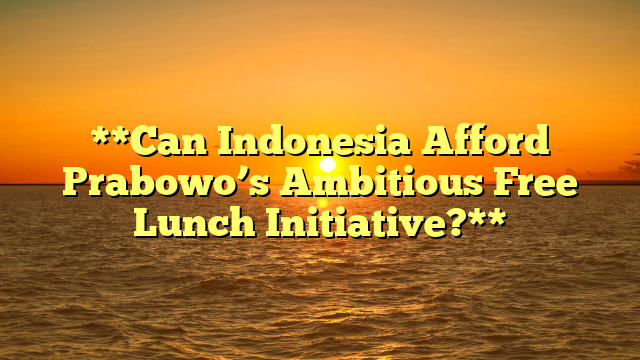
Indonesia, a country with a population of over 270 million, is no stranger to ambitious policy proposals. One of the most talked-about initiatives in recent years is Prabowo Subianto’s free lunch program, which aims to provide nutritious meals to millions of schoolchildren across the nation. While the program has been praised for its potential to address malnutrition and improve educational outcomes, it has also raised significant concerns about its financial feasibility. The question on many minds is: Can Indonesia afford such an ambitious initiative?
The free lunch program is designed to tackle two critical issues: malnutrition and education. According to UNICEF, nearly one in three Indonesian children under five suffers from stunting, a condition caused by chronic malnutrition that affects physical and cognitive development. By providing free, nutritious meals to schoolchildren, the program aims to reduce stunting rates and improve overall health. Additionally, the initiative seeks to boost school enrollment and attendance, particularly among low-income families who struggle to afford daily meals for their children. In theory, the program could lead to a healthier, better-educated population, which would benefit the nation’s long-term economic and social development.
However, the program’s scale and cost have sparked intense debate. Estimates suggest that implementing the free lunch program nationwide could cost the government tens of trillions of rupiah annually. For a country with a GDP per capita of around $4,700, this is a significant financial burden. Critics argue that the program could strain Indonesia’s budget, diverting resources from other critical areas such as infrastructure, healthcare, and defense. They also point to the logistical challenges of delivering meals to remote and underserved areas, where infrastructure is often lacking.
Proponents of the program, on the other hand, argue that the long-term benefits outweigh the costs. A healthier, better-educated population could lead to increased productivity, higher incomes, and reduced poverty rates. Moreover, the program could stimulate local economies by creating jobs in agriculture, food production, and distribution. In keongtogel , the free lunch initiative is not just a social welfare program but an investment in Indonesia’s future.
To assess whether Indonesia can afford Prabowo’s free lunch program, it is essential to consider the country’s fiscal capacity and priorities. Indonesia’s budget is already stretched thin, with significant allocations for infrastructure development, social welfare, and defense. Adding a costly new program could require difficult trade-offs, such as cutting spending in other areas or increasing taxes. However, the government could explore alternative funding mechanisms, such as public-private partnerships or international aid, to share the financial burden.
Another critical factor is the program’s implementation. To be successful, the free lunch initiative must be carefully planned and executed. This includes ensuring transparency in the allocation of resources, building the necessary infrastructure for food distribution, and establishing robust monitoring and evaluation mechanisms to track the program’s impact. Without proper implementation, the program risks becoming a financial black hole, consuming resources without delivering the intended benefits.
In conclusion, while Prabowo’s free lunch program is an ambitious and potentially transformative initiative, its financial feasibility remains a significant concern. Indonesia must carefully weigh the costs and benefits, explore alternative funding mechanisms, and ensure effective implementation to make the program sustainable. If done right, the free lunch initiative could be a valuable investment in the nation’s future. However, if mismanaged, it could become a costly burden that diverts resources from other critical areas. The question of whether Indonesia can afford this ambitious program ultimately depends on the government’s ability to balance its fiscal constraints with its long-term development goals.




